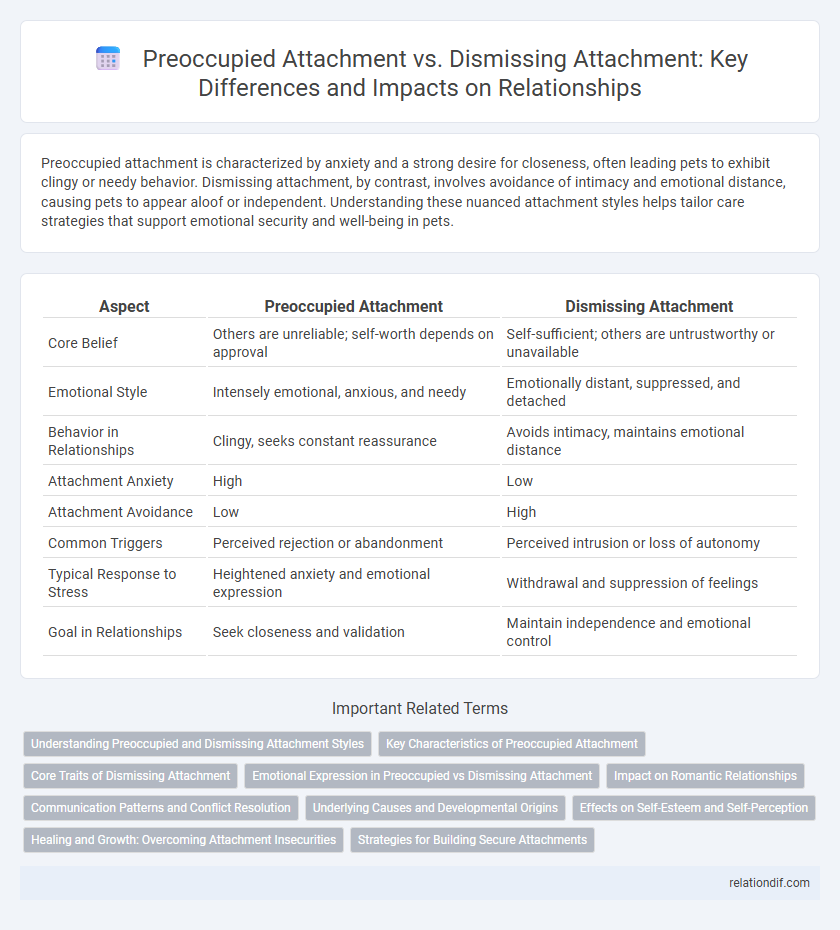Preoccupied attachment is characterized by anxiety and a strong desire for closeness, often leading pets to exhibit clingy or needy behavior. Dismissing attachment, by contrast, involves avoidance of intimacy and emotional distance, causing pets to appear aloof or independent. Understanding these nuanced attachment styles helps tailor care strategies that support emotional security and well-being in pets.
Table of Comparison
| Aspect | Preoccupied Attachment | Dismissing Attachment |
|---|---|---|
| Core Belief | Others are unreliable; self-worth depends on approval | Self-sufficient; others are untrustworthy or unavailable |
| Emotional Style | Intensely emotional, anxious, and needy | Emotionally distant, suppressed, and detached |
| Behavior in Relationships | Clingy, seeks constant reassurance | Avoids intimacy, maintains emotional distance |
| Attachment Anxiety | High | Low |
| Attachment Avoidance | Low | High |
| Common Triggers | Perceived rejection or abandonment | Perceived intrusion or loss of autonomy |
| Typical Response to Stress | Heightened anxiety and emotional expression | Withdrawal and suppression of feelings |
| Goal in Relationships | Seek closeness and validation | Maintain independence and emotional control |
Understanding Preoccupied and Dismissing Attachment Styles
Preoccupied attachment is characterized by an intense desire for closeness combined with anxiety about abandonment, causing individuals to seek constant reassurance in relationships. Dismissing attachment, in contrast, involves a strong preference for independence and emotional distance, with individuals often downplaying the importance of close relationships. Understanding these attachment styles helps in recognizing patterns of emotional regulation and interpersonal behavior that impact relationship dynamics and mental health.
Key Characteristics of Preoccupied Attachment
Preoccupied attachment is characterized by an intense fear of abandonment and a strong desire for closeness, often leading to clinginess and heightened emotional sensitivity. Individuals with preoccupied attachment tend to seek constant validation and reassurance from others while displaying dependency in relationships. In contrast to dismissing attachment, which involves emotional detachment and self-reliance, preoccupied attachment embodies anxiety and insecurity linked to interpersonal connections.
Core Traits of Dismissing Attachment
Dismissing attachment is characterized by emotional detachment, a strong sense of independence, and a tendency to minimize the importance of close relationships. Individuals with this attachment style often suppress feelings and avoid intimacy to maintain self-reliance. Core traits include discomfort with vulnerability, reluctance to seek support, and a preference for emotional distance in interpersonal connections.
Emotional Expression in Preoccupied vs Dismissing Attachment
Preoccupied attachment is characterized by heightened emotional expression, where individuals often exhibit intense and overt displays of feelings, seeking validation and reassurance from others. In contrast, dismissing attachment involves emotional suppression, as individuals tend to minimize or avoid expressing emotions to maintain a sense of independence and distance. This fundamental difference in emotional expression shapes interpersonal dynamics and coping strategies in relationships.
Impact on Romantic Relationships
Preoccupied attachment often leads to heightened emotional dependence and anxiety in romantic relationships, causing persistent fears of abandonment and excessive need for reassurance. In contrast, dismissing attachment fosters emotional distance and reluctance to rely on partners, resulting in challenges with intimacy and effective communication. These contrasting attachment styles significantly influence relationship satisfaction, stability, and conflict resolution patterns.
Communication Patterns and Conflict Resolution
Preoccupied attachment is characterized by heightened emotional expressiveness and a tendency to seek reassurance during conflicts, often resulting in intense communication patterns and difficulty resolving disagreements calmly. Dismissing attachment displays emotional distance, restricted expressions of feelings, and a preference to avoid confrontation, leading to abrupt or minimal communication and unresolved conflicts. These contrasting attachment styles significantly influence how individuals interpret and respond to interpersonal stress, shaping distinct approaches to communication and conflict resolution.
Underlying Causes and Developmental Origins
Preoccupied attachment often stems from inconsistent caregiving and emotional neglect during early childhood, leading to heightened anxiety and hyper-vigilance in relationships. Dismissing attachment typically develops from caregivers who were emotionally unavailable or rejecting, causing individuals to suppress attachment needs and maintain emotional distance. Both attachment styles originate from early interactions with primary caregivers that disrupt secure emotional bonding and influence later relational patterns.
Effects on Self-Esteem and Self-Perception
Preoccupied attachment often results in lower self-esteem due to heightened sensitivity to rejection and a constant need for approval, leading to negative self-perception and emotional dependency. In contrast, dismissing attachment is characterized by elevated self-esteem but is frequently defensive, with individuals valuing independence to the extent of devaluing close relationships, resulting in an inflated or idealized self-image. Both styles significantly impact self-concept, influencing emotional regulation and interpersonal behavior in relationships.
Healing and Growth: Overcoming Attachment Insecurities
Healing from preoccupied attachment involves developing self-awareness and practicing emotional regulation to reduce anxiety and dependency in relationships. Overcoming dismissing attachment requires fostering vulnerability and building trust to counteract avoidance and emotional distance. Both attachment styles benefit from therapy and consistent interpersonal support to promote secure and healthy relational patterns.
Strategies for Building Secure Attachments
Preoccupied attachment often involves hyperactivation strategies, such as seeking constant reassurance and displaying heightened emotional sensitivity, while dismissing attachment is characterized by deactivation strategies, including emotional withdrawal and reluctance to depend on others. Effective strategies for building secure attachments emphasize consistent responsiveness, emotional availability, and fostering trust through open communication to help individuals move toward balanced relational patterns. Therapeutic approaches like Emotionally Focused Therapy (EFT) and mindfulness-based interventions support overcoming attachment insecurities by enhancing self-awareness and emotional regulation skills.
preoccupied attachment vs dismissing attachment Infographic

 relationdif.com
relationdif.com